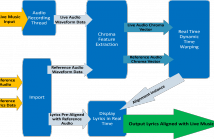- Read more about DRUM TRANSCRIPTION FROM POLYPHONIC MUSIC WITH RECURRENT NEURAL NETWORKS
- Log in to post comments
Automatic drum transcription methods aim at extracting a symbolic representation of notes played by a drum kit in audio recordings. For automatic music analysis, this task is of particular interest as such a transcript can be used to extract high level information about the piece, e.g., tempo, downbeat positions, meter, and genre cues. In this work, an approach to transcribe drums from polyphonic audio signals based on a re- current neural network is presented. Deep learning techniques like dropout and data augmentation are applied to improve the generalization capabilities of the system.
- Categories:
 57 Views
57 Views- Read more about Polyphonic Piano Note Transcription with Non-negative Matrix Factorization of Differential Spectrogram
- Log in to post comments
- Categories:
 7 Views
7 Views- Read more about DETECTION OF IMPULSIVE DISTURBANCES IN ARCHIVE AUDIO SIGNALS
- Log in to post comments
The problem of detection of impulsive disturbances in archive audio signals is considered. It is shown that semi-causal/noncausal solutions based on joint evaluation of signal prediction errors and leave-one-out signal interpolation errors, allow one to noticeably improve detection results compared to the prediction-only based solutions. The proposed approaches are evaluated on a set of clean audio signals contaminated with real click waveforms extracted from silent parts of old gramophone recordings.
- Categories:
 8 Views
8 Views- Read more about The Singing Voice Before and After Vocal Warm-up by Students of Chinese National Singing
- Log in to post comments
This paper compared the singing voices of four student singers of Chinese national singing before and after vocal warm-up. Statistics showed that the parameters such as deviation from the standard note, vibrato rate and jitter were undergoing significant changes after 30 minutes of warming up exercise, while the differences of vibrato extent demonstrated a controversy result.
- Categories:
 5 Views
5 Views- Read more about The Singing Voice Before and After Vocal Warm-up by Students of Chinese National Singing
- Log in to post comments
This paper compared the singing voices of four student singers of Chinese national singing before and after vocal warm-up. Statistics showed that the parameters such as deviation from the standard note, vibrato rate and jitter were undergoing significant changes after 30 minutes of warming up exercise, while the differences of vibrato extent demonstrated a controversy result.
- Categories:
 10 Views
10 Views
Live musical performances (e.g., choruses, concerts, and operas) often require the display of lyrics for the convenience of the audience. This requires following the performance and controlling the lyrics display in real time. In practice, this is usually controlled by a staff member of the concert who has been very familiar with the performance. In this paper, we present our effort in implementing a computational system to automate this real-time lyric display process using music following techniques.
- Categories:
 313 Views
313 Views- Read more about Automatic Chord Estimation on SeventhsBass Chord Vocabulary Using Deep Neural Network
- Log in to post comments
ICASSP2016.pdf
- Categories:
 37 Views
37 Views